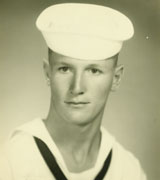Bulls-eye: Aerial Gunnery Practice aboard the Sally Maru

During my tour of duty aboard the Sally, I held several jobs during General Quarters, mostly on the Bridge or in CIC. The one that I enjoyed the most, and that I felt best suited my experience, was that of pointer on "Sky Aft", the after 5" gun director. I was the fellow who actually aimed and fired the after 5" guns while peering through a telescopic sight and pulling the trigger. I had been an avid hunter and gun enthusiast during my teenage years, and I felt right at home in that billet. The gun director tub was positioned just aft of the stack, above and in between the port and starboard 5" guns, so that it could be used to aim either one with the flip of a switch. The director was also connected to a radar set that was used to determine the distance to the target and thus properly set the fuse in the projectile.
If memory serves after 53 years, the incident I am about to describe occurred during aerial gunnery practice off the coast of California, probably in 1956. We were firing at sleeves towed by an aircraft while passing down the port side of the ship. I centered the crosshairs of the gun sight on the sleeve, and when the order came to fire, I pulled the trigger. The shell burst parted the towing cable, and the sleeve came fluttering down. My elevation was perfect, but my windage appeared to be a little off. It looked as though the cable had parted about midway between the sleeve and the towing aircraft. I was astounded; I had never missed anything by that far in my entire life. Needless to say, that particular exercise was over. The towing plane departed, wanting nothing more to do with gunners that couldn't shoot any better than that.
There was never anything official, but scuttlebutt had it that the authorities were mightily displeased, and that someone was going to swing from the yardarm for this careless performance of duty. It didn't take a nuclear physicist to figure out that the "swingee" was probably going to be me. After all, I was the fellow who aimed the gun and pulled the trigger. Someone was surely going to put me on report, and I seem to recall the words "Captain's mast" and worse being bandied about by the rumor mill. I could see my stripes and my job in the gun director going down the proverbial tubes.
After a day or so of sweating it out, the word finally came down that a close examination of the gun sight had revealed that the lead mechanism built into the sight had malfunctioned and that I was off the hook. I not only retained my job as pointer, but I later became the senior petty officer in charge of the gun director during General Quarters.
I suppose that the moral of this story is that being sure of your aim may be of some help, but it comes with no guarantee. Being lucky is a whole lot better.
About the Author
After leaving the Sally Maru in Subic Bay, Charlie went to Los Angeles, where he married his waiting sweetheart. He attended Cal Poly, Pomona for four years and earned a B.S. in Biological Sciences. He then went North to Washington State University in Pullman, Washington for another four years, emerging with a Ph.D. in Plant Pathology. He was hired by the USDA as a Research Plant Pathologist, and he spent the next 40 years working on the biological control of cotton seed and seedling diseases and on soil microbiology. He also served as an adjunct professor in the department of Plant Pathology and Microbiology at Texas A&M University. He then retired in Bryan, Texas, where he and his wife enjoy the company of their 4 children and 4 grandchildren.
